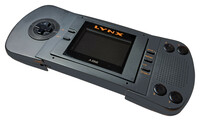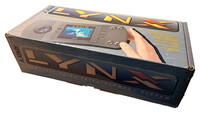Atari Lynx
| Home > Browse Our Collection > Games Consoles > Atari > Atari Lynx |
|
Originally named the Handy, and developed by Epyx, the machine eventually found itself in the hands of Atari. Launching in late 1989, it was the worlds first colour handheld console, and proved to be very popular in Europe. Although selling well below the Game Boy and Game Gear, the machine has an exceptionally good quality library of games such Chips Challenge, California Games and Roadblasters, a healthy homebrew scene kept the library expanding well into the 2000s. The system is also notable for its forward-looking Features, advanced graphics, and ambidextrous layout. The Lynx was eventually discontinued in 1992 by Atari, so they could concentrate on the ill fated Panther and Jaguar projects, a decision especially regretted by Atari's UK head Darryl Still. The Atari Lynx had several innovative features including it being the first colour handheld, with a Backlit display, a switchable right-handed/left-handed (upside down) configuration, and the ability to network with up to 17 other units via its "ComLynx” system (though most games would network eight or fewer players). ComLynx was originally developed to run over infrared links (Codenamed RedEye), This was changed to a cable-based networking system before the final release. The Lynx was the second handheld console from Atari to be produced; the first was Atari Inc.’s "Touch Me”; Atari Inc. had previously worked on several other handheld projects including the Breakout and Space Invaders, the Atari Cosmos portable/tabletop console, and the Atari Atlantis. However, those projects were shut down during development, some just short of their intended commercial release. The first generations of cartridges were flat, and were designed to be stackable. However, this design was proved to be very difficult to remove from the console and were replaced by the second generation of cartridges called Tabbed or ridged, these used the same basic design but with to small tabs on the underside of the cartridge to aid the removal, The original flat style cartridges could be stacked on top of the newer cartridges, but the newer cartridges could not be easily stacked on each other, nor were they stored easily. Thus a third style, the "curved lip" style was produced. The Atari Lynx needed six batteries, and the Game Boy needed four, with the Lynx’s backlight screen, it would drain six AA batteries in less than 3 hours, however as battery technology has progressed, the battery life with lithium batteries is now more than six hours. This Lynx apparently was used in the development of the Chips Challenge conversion for the Spectrum and Amstrad. The pictures to the right are to represent the features of the Lynx and are not of the actual unit. Manufacturer: Atari Atari Lynx Articles:
Magazines RELATED to Atari Lynx in our Library
Other Systems Related To Atari Lynx:
This exhibit has a reference ID of CH70868. Please quote this reference ID in any communication with the Centre for Computing History. |
Click on the Image(s) For Detail
|




























